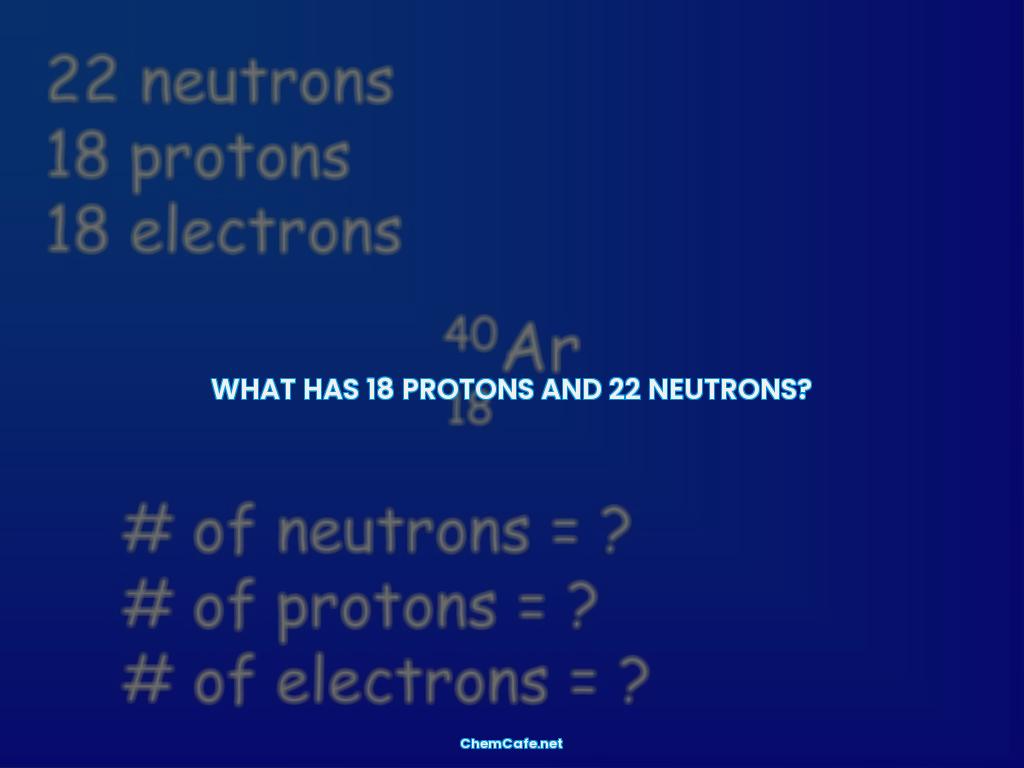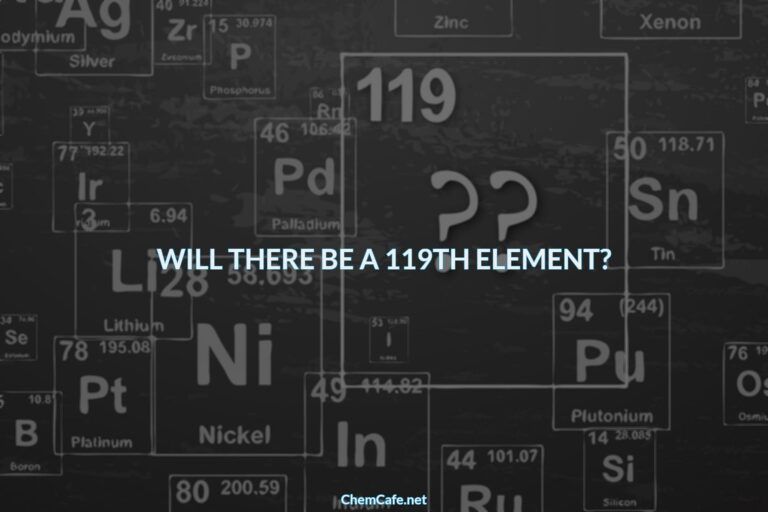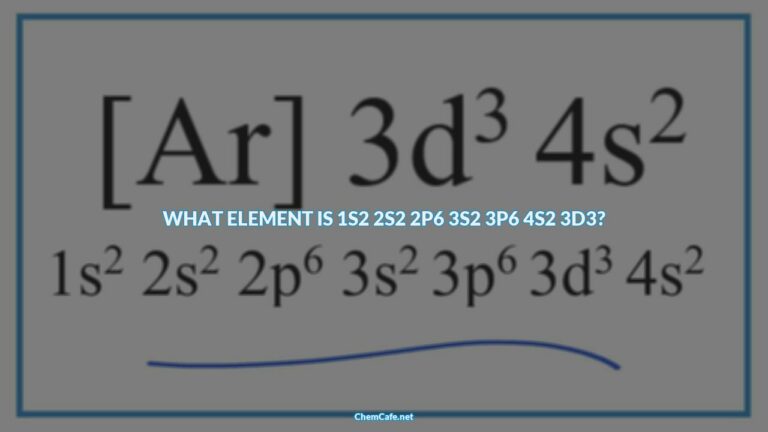When it comes to atoms and molecules, what does it mean to have 18 protons and 22 neutrons? This question is one of the most important for any scientist, as understanding the properties of atoms and molecules is essential for understanding the world around us. In this blog post, we will explore the answer to this question, and uncover the importance of protons and neutrons in an atom.
Atoms are the building blocks of all matter, and they can be broken down into protons and neutrons. Protons are positively charged particles, while neutrons are neutral. In a neutral atom, these two particles are equal in number. This means that when talking about atoms, the total number of protons and neutrons is the same.
In the case of the atom with 18 protons and 22 neutrons, it is an atom of Argon. Argon is an element on the periodic table with the atomic number 18. This means it has 18 protons in its nucleus. Since a neutral atom of Argon also has 22 Neutrons, this is not an isotope but a neutral atom of Argon.
The number of neutrons in an atom of a particular isotope determines the atomic weight of that isotope. This is why isotopes are identified by their mass, which is the total number of protons and neutrons. In an atom of 38Ar, for example, there are 84 protons and 46 neutrons.
The electron configuration of Argon 18, which contains 18 protons and 22 neutrons, is 1s22s22p63s23p6. This means that there are six 3s electrons in Argon. You can read more about electron configurations in our blog post here!
Having 18 protons and 22 neutrons in an atom of Argon is important, as it shows the balance between the positively charged protons and the neutral neutrons. It is important to remember that the number of protons and neutrons in an atom determines its properties and behavior, so understanding this balance is key to understanding atoms and molecules.
We hope this blog post has helped to answer the question “What has 18 protons and 22 neutrons?” and given you a better understanding of atoms and molecules. As always, if you have any questions, please don’t hesitate to ask us!
What has 18 protons and 22 neutrons?
The atom of Argon has 18 protons and 22 neutrons. This is because the number of protons in an atom determines its atomic number, and the number of neutrons determines its atomic weight. Together, these two numbers tell us what kind of atom it is.
Atoms of the same element can have different numbers of neutrons, giving them different atomic weights. These atoms are known as isotopes. Isotopes of an element have the same number of protons but different numbers of neutrons. The isotope of Argon with 18 protons and 22 neutrons is called 40Ar. This isotope has an atomic weight of 40, which is higher than the atomic weight of other isotopes of Argon.
Which Element Contains 84 Protons?
The element with 84 protons is uranium. This is because uranium has an atomic number of 92, which is the sum of its protons and neutrons. Uranium is a radioactive element and is found in nature in small amounts. It is used in nuclear power plants, weapons, and medical imaging.
How Many Neutrons Does Argon 37 Have?
The isotope of Argon with 37 neutrons is called Argon-37. It has 18 protons and 19 neutrons in its nucleus. This makes it very similar to argon-36, which has a nucleus comprising 18 protons and 17 neutrons.
How Many 3s Electrons Are In Argon?
Argon has six 3s electrons. This is because the number of electrons in an atom is equal to its atomic number, which is 18 for Argon. The electrons are arranged in shells, with the outermost shell containing the 3s electrons.
Which Is The Correct Electron Configuration Of Argon 18?
The correct electron configuration of Argon 18 is 1s22s22p63s23p6. This means that the atom has two electrons in the 1s shell, two electrons in the 2s shell, six electrons in the 2p shell, three electrons in the 3s shell, and six electrons in the 3p shell. This configuration is known as the ground state of Argon.
How Many Protons And Neutrons Are In An Atom Of 38 Ar?
The isotope of Argon with 38 neutrons is called 38Ar. It has 18 protons and 20 neutrons in its nucleus. This makes it very similar to argon-36, which has a nucleus comprising 18 protons and 17 neutrons. The atomic weight of 38Ar is 38, which is higher than the atomic weight of other isotopes of Argon.
In conclusion, the atom of Argon has 18 protons and 22 neutrons. This is because the number of protons in an atom determines its atomic number, and the number of neutrons determines its atomic weight. Isotopes of an element have the same number of protons but different numbers of neutrons. The isotope of Argon with 18 protons and 22 neutrons is called 40Ar. The element with 84 protons is uranium. The isotope of Argon with 37 neutrons is called Argon-37. Argon has six 3s electrons and the correct electron configuration of Argon 18 is 1s22s22p63s23p6. The isotope of Argon with 38 neutrons is called 38Ar.
What element has 18 protons 18 electrons 22 neutrons?
Atoms are the building blocks of matter, and each element has its own unique atom. Every element is defined by the number of protons in its nucleus, which is known as its atomic number. The element with an atomic number of 18 has 18 protons and 18 electrons, and its mass number is 40. This means that it has 22 neutrons in its nucleus. So, the element with 18 protons, 18 electrons, and 22 neutrons is argon.
Argon is a noble gas, meaning it is highly stable and non-reactive. It is the third most abundant gas in the Earth’s atmosphere, making up 0.934% of the air we breathe. Argon is one of the most versatile elements, and is used in a variety of applications such as welding, lighting, and lasers.
What is an isotope?
Atoms of the same element can have different numbers of neutrons in the nucleus, making them different forms of the same element, known as isotopes. Isotopes are atoms of the same element with different numbers of neutrons in the nucleus. These different forms of the element have different physical and chemical properties.
For example, the element carbon has three naturally occurring isotopes: carbon-12, carbon-13, and carbon-14. Carbon-12 has six protons and six neutrons, carbon-13 has six protons and seven neutrons, and carbon-14 has six protons and eight neutrons. All three isotopes have the same number of protons, but because they have different numbers of neutrons, they have different properties.
What are the applications of isotopes?
Isotopes are used in a variety of applications, from medical imaging to food safety. Isotopes of elements such as carbon, oxygen, and hydrogen are used in medical imaging, such as positron emission tomography (PET) scans, to detect and diagnose diseases. Isotopes are also used in food safety and food production to detect the presence of contaminants and to measure the nutritional content of food.
Isotopes are also used in industry and research. Radioisotopes are commonly used in industry for applications such as monitoring equipment for leaks or corrosion, and for measuring the thickness of materials. Radioisotopes are also used in research to study the properties of materials, and to study the biochemical processes of living organisms.
The element with 18 protons, 18 electrons, and 22 neutrons is argon. Isotopes are atoms of the same element with different numbers of neutrons in the nucleus, and they have different physical and chemical properties. Isotopes are used in a variety of applications, from medical imaging to food safety, and in industry and research.
What is argon 18 protons 22 neutrons?
Argon is an odorless, colorless, and tasteless gas with an atomic number of 18. It is the third-most abundant element in the Earth’s atmosphere, making up 0.934% of the atmosphere by volume. With 18 protons, 22 neutrons, and 18 electrons, it is a noble gas with a molecular weight of 39.948 g/mol.
The protons and neutrons in argon are located in its nucleus, which is composed of protons and neutrons. The number of protons in the nucleus of an atom is called the atomic number, and is denoted by the symbol Z. Argon has an atomic number of 18, which means that it has 18 protons in its nucleus. The number of neutrons in argon is 22, making the total number of protons and neutrons 40.
Properties of Argon
Argon is a non-reactive gas, meaning that it does not react with other elements or compounds. This makes it useful for a variety of applications, such as in fire extinguishers and welding. Argon is also used in fluorescent lamps and as a shielding gas in arc welding.
Argon has a boiling point of -185.9°C and a melting point of -189.3°C. It is the most dense of the noble gases, and its density increases with temperature. At 0°C, argon has a density of 1.784 g/L.
Uses of Argon
Argon is used in a variety of industries, including welding, lighting, and fire protection. It is also used to create an inert atmosphere in food packaging, to preserve food freshness and prevent spoilage.
In welding, argon is used as a shielding gas to protect the weld from oxidation. It is also used in the production of steel, aluminum, and other alloys. Argon is used in fluorescent lamps to create a bright white light.
In the fire protection industry, argon is used in fire extinguishers to protect against flammable liquids and gases. It is also used in smoke detectors to detect the presence of smoke.
Argon is a noble gas with an atomic number of 18, meaning it has 18 protons in its nucleus. It has a total of 40 protons and neutrons, and 18 electrons. Argon is a non-reactive gas, and has a boiling point of -185.9°C and a melting point of -189.3°C. It is used in a variety of industries, such as welding, lighting, and fire protection.
What element has 22 neutrons and protons?
Isotopes are atoms with the same atomic number but different mass numbers. Every element has a different number of protons and neutrons, which is why they have different chemical properties. This also means that they can be identified by their mass, which is the total number of protons and neutrons.
There are two ways that isotopes are generally written. They both use the mass of the atom where mass = (number of protons) + (number of neutrons).
Finding the Element with 22 Neutrons and Protons
Hey everyone, let’s say we’re given a chart filled with the number of neutrons and protons for four isotopes and were asked what are their symbols? Starting with our first one. We can go ahead and use our number of protons to tell us our atomic number. In this case we have 37. So we have rubidium
Now to use our neutrons. Always remember that the number of protons represent the Atomic no. of that particular element. In this case the number of protons is #18#,So,the atomic no. is also #18#. And the element with atomic no. #18# is #Argon# with symbol #Ar#
Now we need to find the mass number of #Argon# . Because #Mass# #number-Atomic# #number##=##No# #of# #neutrons#
Mass number of Argon=#40#
No of Neutrons#=40-18=22#
A neutral atom of argon also has #22# Neutrons.
Why Isotopes are Important
Isotopes are important in many fields such as geology, medicine, and biology. In geology, isotopes are used to measure the age of rocks and other materials. In medicine, isotopes are used to diagnose and treat certain diseases. In biology, isotopes are used to study the structure and function of organisms.
In conclusion, the element with 22 neutrons and protons is Argon (symbol Ar). Isotopes play an important role in many fields, including geology, medicine, and biology. They can be identified by their mass, which is the total number of protons and neutrons. Understanding how to find the element with a certain number of neutrons and protons is an important skill that can be used in many different applications.
What element has 16 protons and 22 neutrons?
Atoms are composed of protons, neutrons, and electrons that are arranged in an orderly fashion. The number of protons in an atom determines its identity, while the number of neutrons and electrons can vary. This means that some atoms of the same element can have different numbers of neutrons and electrons. These atoms are called isotopes and they can be identified by their atomic mass.
For example, an atom with 16 protons and 22 neutrons is an isotope of the element sulfur. This particular isotope is known as sulfur-34, and it has an atomic mass of 34. The number of protons and neutrons in an isotope of an element is referred to as its mass number, and this number is equal to the sum of the protons and neutrons.
What is an Isotope?
An isotope is an atom of a particular element that has a different number of neutrons than the usual number for that element. Isotopes of an element have the same number of protons, but the number of neutrons can vary. This means that each isotope of an element has a different atomic mass.
Atomic Number and Mass Number
Atoms are also identified by two numbers: their atomic number and their mass number. The atomic number is equal to the number of protons in an atom, and it is used to identify the element. The mass number is equal to the sum of the protons and neutrons in an atom, and it is used to identify isotopes of an element.
When writing the mass number of an atom, it is written as a superscript on the left side of the element’s symbol. For example, the mass number of sulfur-34 is written as 34S.
Examples of Isotopes
Isotopes of some of the most common elements can be found in nature. For example, there are three common isotopes of hydrogen: hydrogen-1, hydrogen-2, and hydrogen-3. Hydrogen-1 is the most common form of hydrogen, and it has one proton and no neutrons. Hydrogen-2, also known as deuterium, has one proton and one neutron. Hydrogen-3, also known as tritium, has one proton and two neutrons.
There are also three common isotopes of carbon: carbon-12, carbon-13, and carbon-14. Carbon-12 has six protons and six neutrons, while carbon-13 has six protons and seven neutrons. Carbon-14 has six protons and eight neutrons.
To summarize, an element has 16 protons and 22 neutrons if it is an isotope of sulfur. This particular isotope is known as sulfur-34 and it has an atomic mass of 34. Isotopes are identified by their mass number, which is the sum of the protons and neutrons in an atom. The atomic number is equal to the number of protons in an atom, and it is used to identify the element. Examples of isotopes include hydrogen-1, hydrogen-2, and hydrogen-3, as well as carbon-12, carbon-13, and carbon-14.
What has 18 electrons and 22 neutrons?
Atoms of elements can differ in the number of neutrons they contain. These variants are called isotopes. An atom of an element with a different number of neutrons than the usual atom is called an isotope.
For example, magnesium (Mg) has three naturally occurring isotopes: 24Mg, 25Mg, and 26Mg. Each of these three forms of Mg has its own unique mass number and atomic number.
Table (PageIndex{1}): Atoms of the First Six Elements
| Element | Protons | Neutrons | Electrons | Atomic Number (Z) | Mass Number (A) |
|---|---|---|---|---|---|
| Hydrogen | 1 | 0 | 1 | 1 | 1 |
| Helium | 2 | 2 | 2 | 2 | 4 |
| Lithium | 3 | 4 | 3 | 3 | 7 |
| Beryllium | 4 | 5 | 4 | 4 | 9 |
| Boron | 5 | 6 | 5 | 5 | 11 |
| Carbon | 6 | 6 | 6 | 6 | 12 |
Since neutral atoms have to have one electron for every proton, an element’s atomic number also tells you how many electrons are in a neutral atom of that element. Therefore, the atomic number also indicates the number of electrons in an atom.
The total number of protons and neutrons in an atom is called its mass number (A). The number of neutrons in that atom is therefore the difference between the mass number (A) and the atomic number (Z).
For example, the three magnesium isotopes (24Mg, 25Mg, and 26Mg) differ only because a 24Mg atom has 12 neutrons in its nucleus, a 25Mg atom has 13 neutrons, and a 26Mg atom has 14 neutrons.
Figure 5.5b Atomic Symbols used to Represent Isotopes of Elements
The symbol for an atom indicates the element via its usual two-letter symbol, the mass number as a left superscript, the atomic number as a left subscript (sometimes omitted), and the charge of its ion as a right superscript.
So, what has 18 electrons and 22 neutrons? The answer is an atom of Magnesium-26 (26Mg). This atom has 12 protons and 14 neutrons, which gives it an atomic number of 12 (12 protons) and a mass number of 26 (12 protons + 14 neutrons). This atom also has 18 electrons, since the atomic number (12) is equal to the number of electrons in a neutral atom.
In summary, isotopes are atoms of the same element that differ in the number of neutrons they contain. This difference can be determined by looking at the atom’s atomic number and mass number. In this case, an atom of Magnesium-26 (26Mg) has 18 electrons and 22 neutrons.





Leave a Comment